Passenger train services • Main line services / Ticketing • Intercity • Austria • OBB • Railjet
➤ Similar operators: Acela – Avanti West Coast – Flixtrain – LNER – Lumo – WESTbahn
Note: For educational purpose only. This page is meant purely as a documentation tool and has no legal effect. It is not a substitute for the official page of the operating company, manufacturer or official institutions. It cannot be used for staff training, which is the responsibility of approved institutions and companies.
In brief
Railjet is – since 2005 – a registered trademark belonging to ÖBB Personenverkher, the passenger subsidiary of the Austrian ÖBB group. The idea came from an in-house marketing workshop whose moderator, the head of a communications company, registered the name a few days later! ÖBB had to pay 180,000 euros to get it back…
As part of its restructuring, the ÖBB Group had set itself the objective of increasing its competitiveness. The basic idea was to renew the rolling stock of the Intercity and Eurocity, long-distance trains that run on an hourly timetable, a concept that has been tried and tested by the Austrian state-owned company. It was also necessary to make a lasting impression with a strong identity celebrating the novelty and dynamism of the public company, since Europe was authorising competition in the long-distance segment by 2010. Finally, the Intercity, Eurocity and Express brand names had to be put in order, and rolling stock and on-board services had to be standardised as far as possible.
Operator: ÖBB-Personenverkehr AG
Subsdiary / Division: 100% ÖBB Holding
Sector: Passengers
Commercial segment: Main Line
International Transport: yes
First services: december 2008
Type of train : pushed/pulled trainset
Manufacturer(s) : Siemens
Traction : ÖBB
Official website : Railjet.com
Social media :
In the meantime, the idea of speeding up journey times on the Vienna-Salzburg line was gaining ground. It was planned to run the fastest trains at up to 230km/h on a short stretch of almost 50 kilometres in Lower Austria, which does not make it a high-speed line in the true sense of the word. Nevertheless, the ÖBB Personenverkher division is incorporating this maximum speed into the specifications for the new rolling stock. Locomotives are not part of the project.
Routes
➤ RJX Budapest / Bratislava – Vienna Hauptbahnof – Linz – Salzburg – Munich Hbf
➤ RJX Vienna Airport – Vienna Hbf – Linz – Salzburg Hbf – Innsbruck – Feldkirch – Bregenz
➤ RJX Vienna Airport – Vienna Hbf – Linz – Salzburg Hbf – Innsbruck – Feldkirch – Zürich Hbf
➤ RJ Vienna Hbf – Klagenfurt – Villach – Udine – Venice
➤ RJ Graz – Mürzzuschlag – Vienna Hauptbahnof – Breclav – Brno – Pardubice hl.n. – Praha hl.n.
➤ RJ Graz – Mürzzuschlag – Wiener Neustadt – Wien Meidling – Vienna Hbf – Vienna Airport
➤ RJ Vienna Hbf – St.Pölten – Linz – Wels – Attnang-Puchheim – Salzburg Hbf
➤ RJ München Hbf – Rosenheim – Innsbruck Hbf – Bolzano/Bozen – Trento – Verona Porta Nuova
➤ … (many others, see details at this page)
Rolling stock (past and present)
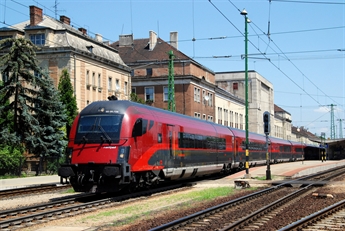
Siemens Viaggio + Taurus
2008 – …
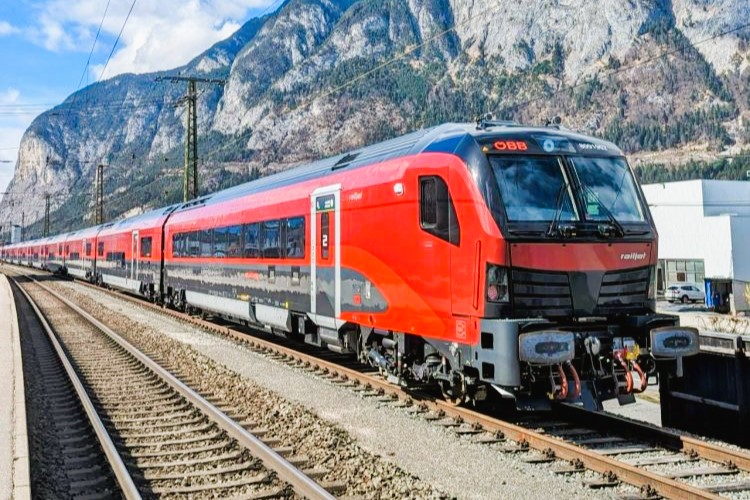
Siemens Viaggio + Vectron
2024 – …
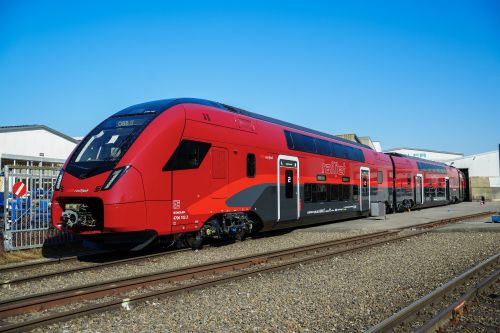
Stadler
2026 – …
We will now go into more detail below and on the following pages.
The general concept
Lightweight, high-comfort reversible push/pull trainsets with 7 carriages: 2 first-class carriages, a restaurant carriage and 4 second-class carriages, i.e. 185.5 m for 330 tonnes. Each trainset and its locomotive can be coupled with a second trainset. The trainsets had to offer much greater comfort and lower production costs. No unnecessary shunting: one end is fitted with a pilot car, allowing reversibility. To achieve this, the locomotives have to be permanently connected to the trainsets, which saves on headway costs, the most important of which are the network usage charge, the working hours of the train drivers and traction services such as washing and maintaining the trains. ‘We hope to save one hour of work per day and per train, or 100 euros’, explained a manager in 2008.
The trains should be able to operate in Germany, Switzerland, the Czech Republic and Hungary. Comfort is available in three classes: Economy class, First class and Premium class, which is a first on the Austrian network.
The winner of the bid
Bids from Bombardier, Siemens and CAF were accepted by ÖBB management in 2005, and at a Board meeting on 9 February 2006, the Supervisory Board of ÖBB-Holding approved the purchase of 23 trainsets worth €245 million, with an option to deliver a further 44 sets up to the end of 2006.
Design and livery
The livery to be adopted is of paramount importance: the aim is to make a mark, to break with the long Intercity / Eurocity period. The Spirit Design agency in Vienna was responsible for the branding. Three different designs were selected and put to the vote by ÖBB customers. In March 2007, two locomotives were selected in the Linz workshops, 1016 034 and 035, simply because they were there for routine maintenance. A third locomotive, 1116 200, had to return to the workshop to have its ‘Semmering 200’ promotional lamination removed. The opportunity was taken to give it the third version of the design. The three machines thus came out with three different liveries, as shown in the photos below.
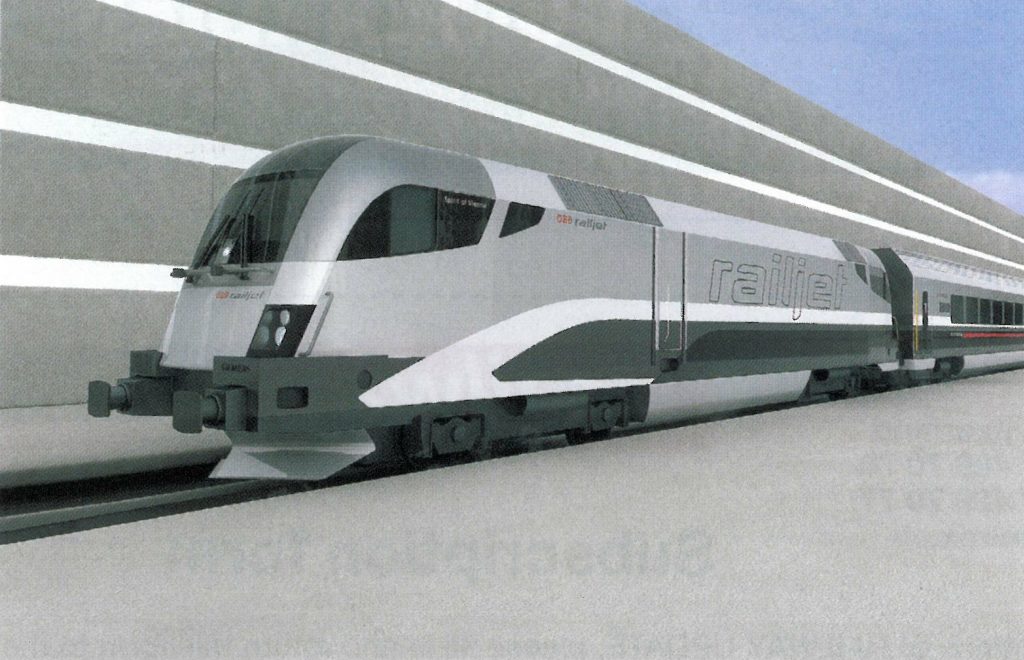
Each of the locomotives had a baptismal name: Spirit of Salzburg, Spirit of Linz and Spirit of Wien. Both 1016 034 and 035 had been given a grey base livery. On the 034, a gradient of grey and a white stripe adorned the lower half of the body. On the 035, the white was replaced by red. The ‘Railjet’ logo was grey on the 034, white on the 035, both with a discreet ‘ÖBB Railjet’ under the roof near the driver’s cabs. These machines ran on various Intercity routes, taking them as far as Busch on the Swiss border.

The 1116 200, meanwhile, sported a different livery. Its basic colour was the very elegant burgundy red, on which the grey gradient and red stripe of the 1016 035 had been used.
The Austrian tabloid ‘Krone’ then carried out a two-month poll on its website where its readers could vote for the future Railjet design, an unprecedented move on the part of a public railway company. On 19 May 2007, the results showed the design of the 1116 200 topping the poll, followed by the 1016 035 and finally the 1016 034. The most popular design was inevitably used on all the coaches. The ‘Railjet’ design was born…
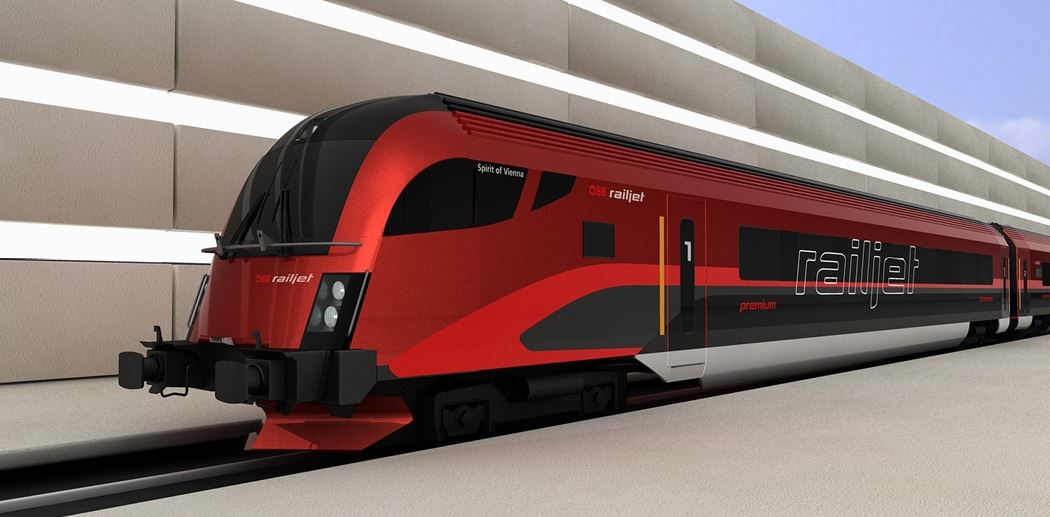
Spirit Design is the agency responsible for the entire interior and exterior design of the Railjets. Tones, colours and choice of materials have been carefully studied, in the knowledge that design plays an important strategic role. Not only does it have a visual function, it also conveys specific messages and creates added value for passengers. The agency’s innovation model, which integrates strategy, product and brand, was used successfully in this project. Some of the elements of the Railjet train design study are shown opposite.


According to the agency, the exterior and interior design of the ÖBB Railjet project is about much more than aesthetics. The design must fulfil important communication functions: the aim is to attract target groups to the train by combining concrete elements of safety, comfort, speed and high technology. The Railjet’s design research had to differentiate it from other modes of transport and offer passengers added value. “The new Railjet is unique in ÖBB’s history. We found the right partner in Spirit Design, which has extensive experience in all areas of application. In addition to appearance, the agency is also able to look at technical issues, material decisions, etc.“, explained Rupert Marl, ÖBB Railjet Project Manager at Personenverkehr AG on the agency’s website.

Colours play an important role in the subjective and individual perception of human beings. Seen from the outside, the ÖBB Railjet evokes associations of dynamism and speed. An impression that is reinforced by the distinctive lettering on both sides of the train. Inside, the only colours used are white, anthracite and silver, derived from selected materials. Above, red accents are used selectively. Slightly coloured indirect lighting elements in the various equipment variants complete the pleasant atmosphere of the railjet. Every detail had to be considered, right down to the interior doors. This is shown in the illustration below.
This design won several awards: in 2008, it was nominated for the Createch Award, presented by the Austrian Federal Ministry of Transport, Innovation and Technology. In 2009, it received the ‘Gute Gestaltung’ award from the German Designer Club and the ‘Red Dot’ quality label from the Designzentrum Nordrhein-Westfalen. The Railjet design was also nominated twice for the German Design Prize (2009 and 2010) and again for the Austrian Design Prize (2009). It was also awarded the ‘Consumer Favorite 09’ prize at the Universal Design Award, which was announced by the iF Designforum in Hannover. Clearly the ÖBB had achieved a master stroke in railway branding…
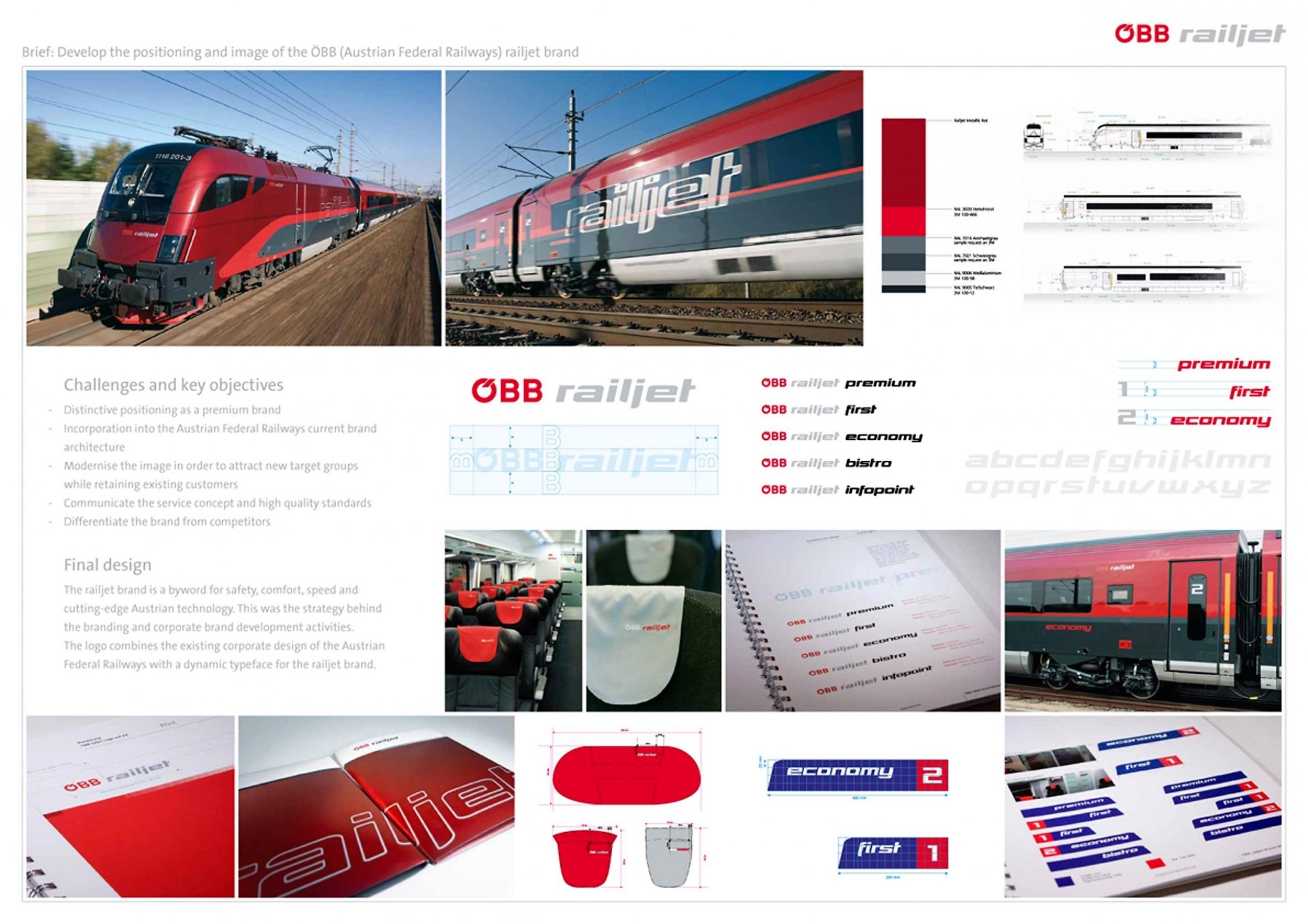
🟧
[TOP]
Main line • Intercity • Austria • OBB • Lexical
